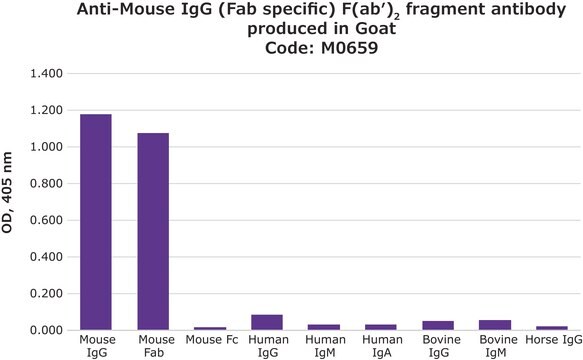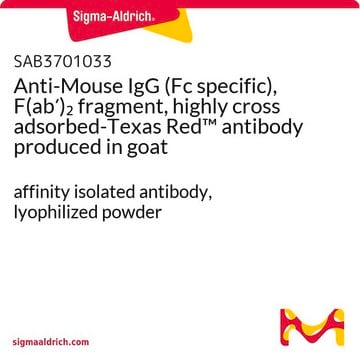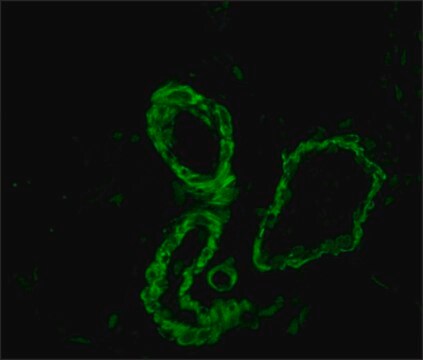F8521
Anti-Mouse IgG (Fab specific) F(ab′)2 fragment–FITC antibody produced in goat
affinity isolated antibody, buffered aqueous solution
About This Item
Productos recomendados
biological source
goat
conjugate
FITC conjugate
antibody form
affinity isolated antibody
antibody product type
secondary antibodies
clone
polyclonal
form
buffered aqueous solution
storage condition
protect from light
technique(s)
immunohistochemistry (formalin-fixed, paraffin-embedded sections): 1:320
storage temp.
−20°C
target post-translational modification
unmodified
¿Está buscando productos similares? Visita Guía de comparación de productos
General description
Specificity
Useful when trying to avoid background staining due to the presence of Fc receptors. Anti-Mouse IgG (Fab specific) F(ab′)2 fragment-FITC antibody recognizes Fab fragment of mouse IgG. No cross reaction is observed with the Fc fragment of mouse IgG. No reactivity is observed with human, horse or bovine serum. The antibody is purified by affinity isolation and conjugated with FITC in an alkaline reaction.
Immunogen
Application
- flow cytometry for fluorescence-activated cell sorting (FACS) analysis
- immunofluorescence and confocal microscopy
- immunofluorescent HSP72 detection/immunocytochemistry experiments
Biochem/physiol Actions
Other Notes
Physical form
Preparation Note
Disclaimer
Not finding the right product?
Try our Herramienta de selección de productos.
Storage Class
10 - Combustible liquids
wgk_germany
nwg
flash_point_f
Not applicable
flash_point_c
Not applicable
ppe
Eyeshields, Gloves, multi-purpose combination respirator cartridge (US)
Certificados de análisis (COA)
Busque Certificados de análisis (COA) introduciendo el número de lote del producto. Los números de lote se encuentran en la etiqueta del producto después de las palabras «Lot» o «Batch»
¿Ya tiene este producto?
Encuentre la documentación para los productos que ha comprado recientemente en la Biblioteca de documentos.
Los clientes también vieron
Nuestro equipo de científicos tiene experiencia en todas las áreas de investigación: Ciencias de la vida, Ciencia de los materiales, Síntesis química, Cromatografía, Analítica y muchas otras.
Póngase en contacto con el Servicio técnico










